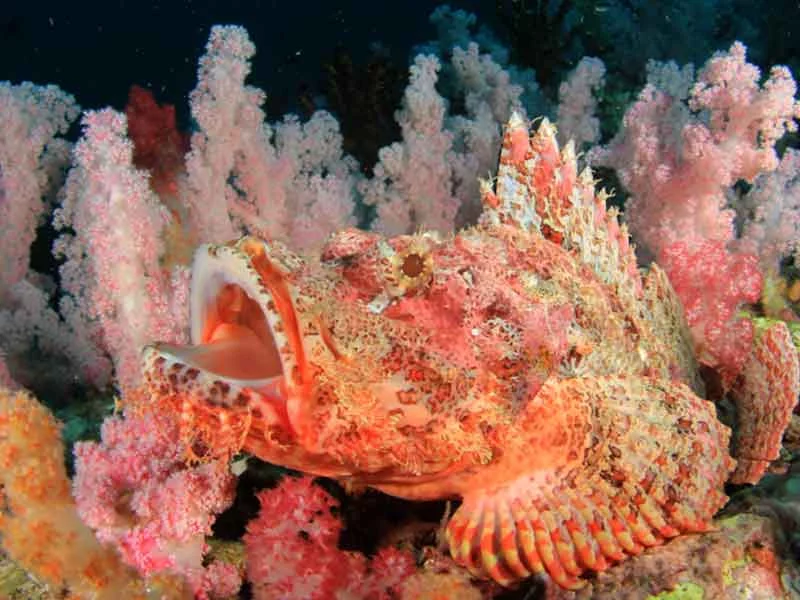Scorpionfish are related to other fish in the family Scorpaenidae, which includes over 400 species of fish. Some of the most well-known and closely related fish in this family include scorpionfish, lionfish, and stonefish. All of these fish are characterized by their venomous spines, which are used for defense against predators.
Scorpionfish can be found in many diving locations around the world, especially in warm and tropical waters. You have probably encountered them on many dives. Here are 10 interesting facts about scorpionfish that you may not know.
1. Big mouth
Scorpionfish are able to stretch their jaws and expand their mouth cavity, which allows them to swallow prey that is larger than their own body size. This allows them to consume a wider variety of prey and to consume more food in a single feeding event, which can be important for their survival.
Additionally, the flexible jaw of scorpionfish allows them to rapidly expand their mouth when they are feeding, creating a vacuum that sucks prey into their mouth.
2. Shine in the dark
Scorpionfish can have bioluminescent properties. Some scorpionfish species, like the Weedy Scorpionfish, have special light-producing cells in their skin that allow them to produce their own light. This can be used to attract prey, communicate with other fish, or as a form of camouflage.
3. Breathing
Scorpionfish have a unique respiratory system that is more efficientl than most fish. They have large gill chambers and a specialized system of small blood vessels that help them extract oxygen from the water more efficiently.
Scorpionfish can effectively extract oxygen from the water even when they are lying on the bottom of the ocean, as they often do.
Like many other fish, scorpionfish open and close their mouth to draw water over their gills. However, scorpionfish have a specialized muscle that compresses the cheeks. This allows scorpionfish to more effectively draw water over their gills, even when they are not swimming actively.

Bearded Scorpionfish
4. Lethal
The venom of scorpionfish, including the Stonefish, can be extremely toxic to humans. It is a complex mixture of toxins that can cause a variety of symptoms in humans and other animals. The toxins in scorpionfish venom can affect the nervous system, cardiovascular system, and other organ systems, and can be potentially lethal in some cases.
Symptoms of scorpionfish stings can include severe pain, swelling, redness, and discoloration at the site of the sting, as well as nausea, vomiting, and difficulty breathing. In severe cases, envenomation can lead to respiratory failure, paralysis, and even death.
Overall, while scorpionfish are generally not aggressive toward humans and will only sting if they feel threatened.
5. Mood
Scorpionfish and stonefish are able to change color depending on their mood, surroundings, and even the time of day. This is accomplished through the movement of pigmented cells in their skin called chromatophores, which can create a range of colors and patterns.
By changing color to match the surroundings, scorpionfish can become virtually invisible to their prey or predators.
Scorpionfish also change color to communicate with other members of their species. For example, males may change color to signal their readiness to mate, or as a warning to potential rivals.

Happy Stonefish ….. Angry Stonefish
6. Sensitive
Scorpionfish have specialized organs called neuromasts that allow them to detect changes in water pressure and vibrations. These organs are particularly useful for detecting the movement of prey or potential predators.
Neuromasts are similar in structure to the ampullae of Lorenzini found in sharks and rays. However, sharks and rays use their ampullae of Lorenzini primarily for the detection of electrical fields. Neuromasts in Scorpionfish are more used for the detection of water movement and pressure.
7. Mating
The mating ritual of scorpionfish involves a complex dance between the male and female. The male scorpionfish will approach the female and begin a series of movements and displays to court her. This may involve flaring the fins, changing color, and quivering the body. The female may also engage in similar displays to signal her readiness to mate.
Once the pair has established a connection, the male will position himself next to the female and align his body with hers.
After mating, the female scorpionfish will carry the fertilized eggs for several days, even weeks, before releasing her eggs in a safe location, such as a rocky crevice or a protected area on the ocean floor.
The eggs of scorpionfish typically hatch after a few days to a few weeks. The young scorpionfish, known as larvae, will then begin to feed on plankton and other small organisms until they are large enough to hunt for prey on their own.

Stonefish
8. Communication
Stonefish and scorpionfish use a variety of visual and chemical cues to communicate with other members of their species.
One way that scorpionfish communicate is through their body posture and movements. For example, they may raise or lower their dorsal fin or pectoral fins, arch their back, or tilt their head in a certain way to communicate different messages to other fish.
Scorpionfish also use chemical cues to communicate with other fish. They release chemical substances (pheromones) to attract mates, mark territory, or signal the presence of predators or prey.
Finally, scorpionfish also communicate through visual displays, such as changing their coloration or flashing their fins in a certain way.
9. Regenerate
Scorpionfish have the ability to regenerate lost fins and spines over time, which can be a valuable adaptation for their survival. This can allow them to recover from injuries or damage to their protective spines, which are important for defense.
10. Beautiful
Some species of scorpionfish can be very colorful, and many are actually quite beautiful. While most scorpionfish are generally brown or mottled in coloration to help them blend in with their surroundings, some species have evolved bright colors and intricate patterns for various reasons, such as to attract mates or warn potential predators of their venomous spines.

Weedy Scorpionfish
